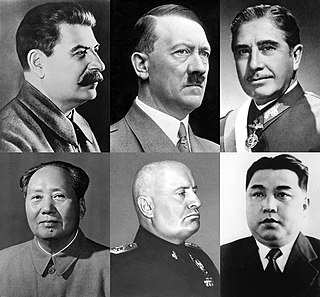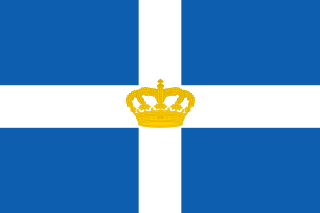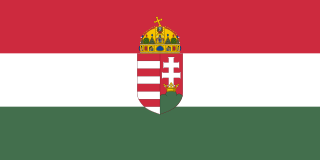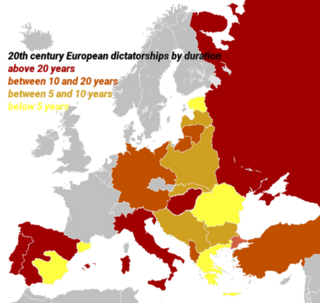
A dictator is a political leader who possesses absolute power. A dictatorship is a state ruled by one dictator or by a small clique. The word originated as the title of a Roman dictator elected by the Roman Senate to rule the republic in times of emergency.

A dictatorship is an autocratic form of government which is characterized by a leader, or a group of leaders, who hold governmental powers with few to no limitations. Politics in a dictatorship are controlled by a dictator, and they are facilitated through an inner circle of elites that includes advisers, generals, and other high-ranking officials. The dictator maintains control by influencing and appeasing the inner circle and repressing any opposition, which may include rival political parties, armed resistance, or disloyal members of the dictator's inner circle. Dictatorships can be formed by a military coup that overthrows the previous government through force or they can be formed by a self-coup in which elected leaders make their rule permanent. Dictatorships are authoritarian or totalitarian, and they can be classified as military dictatorships, one-party dictatorships, personalist dictatorships, or absolute monarchies.
A head of state is the public persona of a sovereign state. The specific naming of the head of state depends on the country's form of government and separation of powers, the head of state may be a ceremonial figurehead or concurrently the head of government and more.

The Weimar Republic, officially known as the German Reich, was a historical period of Germany from 9 November 1918 to 23 March 1933, during which it was a constitutional federal republic for the first time in history; hence it is also referred to, and unofficially proclaimed itself, as the German Republic. The period's informal name is derived from the city of Weimar, which hosted the constituent assembly that established its government. In English, the republic was usually simply called "Germany", with "Weimar Republic" not commonly used until the 1930s.
Autocracy is a system of government in which absolute power is held by the ruler, known as an autocrat. It includes most forms of monarchy and dictatorship, while it is contrasted with democracy and feudalism. Various definitions of autocracy exist. They may restrict autocracy to a single individual, or they may also apply autocracy to a group of rulers who wield absolute power. The autocrat has total control over the exercise of civil liberties within the autocracy, choosing under what circumstances they may be exercised, if at all. Governments may also blend elements of autocracy and democracy, forming an anocracy. The concept of autocracy has been recognized in political philosophy since ancient times.
A military dictatorship, or a military regime, is a type of dictatorship in which power is held by one or more military officers. Military dictatorships are led by either a single military dictator, known as a strongman, or by a council of military officers known as a military junta. They are most often formed by military coups or by the empowerment of the military through a popular uprising in times of domestic unrest or instability. The military nominally seeks power to restore order or fight corruption, but the personal motivations of military officers will vary.
A cult of personality, or a cult of the leader, is the result of an effort which is made to create an idealized and heroic image of a glorious leader, often through unquestioning flattery and praise. Historically, it has developed through techniques of mass media, propaganda, spectacle, the arts, patriotism, and government-organized demonstrations and rallies. A cult of personality is similar to apotheosis, except that it is established by modern social engineering techniques, usually by the state or the party in one-party states and dominant-party states. Cults of personality often accompany the leaders of totalitarian or authoritarian governments. They can also be seen in some monarchies, theocracies, failed democracies and even in liberal democracies.
Article 48 of the constitution of the Weimar Republic of Germany (1919–1933) allowed the Reich president, under certain circumstances, to take emergency measures without the prior consent of the Reichstag. This power came to be understood to include the promulgation of emergency decrees. It was used frequently by Reich President Friedrich Ebert of the Social Democratic Party to deal with both political unrest and economic emergencies. Later, under President Paul von Hindenburg and the presidential cabinets, Article 48 was called on more and more often to bypass a politically fractured parliament and to rule without its consent. After the Nazi Party's rise to power in the early 1930s, the law allowed Chancellor Adolf Hitler, with decrees issued by Hindenburg, to create a totalitarian dictatorship by seemingly legal means.

The Bavarian Soviet Republic, or Munich Soviet Republic, was a short-lived unrecognised socialist state in Bavaria during the German Revolution of 1918–1919. It took the form of a workers' council republic. Its name is also sometimes rendered in English as the Bavarian Council Republic; the German term Räterepublik means a republic of councils or committees, and council or committee is also the meaning of the Russian word soviet. It was established in April 1919 after the demise of Kurt Eisner's People's State of Bavaria and sought to establish a socialist republic in Bavaria. It was overthrown less than a month later by elements of the German Army and the paramilitary Freikorps. Several individuals involved in its overthrow later joined the Nazi Party during its subsequent rise to power, even though Adolf Hitler himself had been, at least publicly, a supporter of the Bavarian Soviet Republic.

The Restoration, or Bourbon Restoration, is the name given to the period that began on 29 December 1874—after a coup d'état by General Arsenio Martínez Campos ended the First Spanish Republic and restored the monarchy under Alfonso XII—and ended on 14 April 1931 with the proclamation of the Second Spanish Republic.

The 4th of August Regime, commonly also known as the Metaxas regime, was an authoritarian regime under the leadership of General Ioannis Metaxas that ruled the Kingdom of Greece from 1936 to 1941. On 4 August 1936, Metaxas, with the support of King George II, suspended the Greek parliament and went on to preside over a conservative, staunchly anti-communist government. The regime took inspiration in its symbolism and rhetoric from Fascist Italy, but retained close links to Britain and the French Third Republic, rather than the Axis powers. Lacking a popular base, after Metaxas' death in January 1941 the regime hinged entirely on the King. Although Greece was occupied following the German invasion of Greece in April 1941 and the Greek government was forced into exile in the British-controlled Kingdom of Egypt, several prominent figures of the regime, notably the notorious security chief Konstantinos Maniadakis, survived for several months in cabinet until the King was forced to dismiss them in a compromise with the representatives of the old democratic political establishment.

Adolf Hitler was an Austrian-born German politician who was the dictator of Germany from 1933 until his suicide in 1945. He rose to power as the leader of the Nazi Party, becoming the chancellor in 1933 and then taking the title of Führer und Reichskanzler in 1934. During his dictatorship, he initiated World War II in Europe by invading Poland on 1 September 1939. He was closely involved in military operations throughout the war and was central to the perpetration of the Holocaust, the genocide of about six million Jews and millions of other victims.

Adolf Hitler's rise to power began in the newly established Weimar Republic in September 1919 when Hitler joined the Deutsche Arbeiterpartei. He rose to a place of prominence in the early years of the party. Being one of its most popular speakers, he was made the party leader after he threatened to otherwise leave.
A benevolent dictatorship is a government in which an authoritarian leader exercises absolute political power over the state, but is perceived to do so with regard for benefit of the population as a whole, standing in contrast to the decidedly malevolent stereotype of a dictator who focuses on their supporters and their own self-interests. A benevolent dictator may allow for some civil liberties or democratic decision-making to exist, such as through public referendums or elected representatives with limited power, and can make preparations for a transition to genuine democracy during or after their term.
A supreme leader or supreme ruler typically refers to the person among a number of leaders of a state, organization or other such group who has been given or is able to exercise the most – or complete – authority over it. In a religion, this role is usually satisfied by a person deemed to be the representative or manifestation of a deity or God on Earth. In politics, a supreme leader usually rules over an authoritarian or totalitarian government and has a cult of personality associated with them. Historic examples are Adolf Hitler of Nazi Germany, Francisco Franco of Francoist Spain, Benito Mussolini of Fascist Italy and Joseph Stalin of the Soviet Union.

The Kingdom of Hungary, referred to retrospectively as the Regency and the Horthy era, existed as a country from 1920 to 1946 under the rule of Miklós Horthy, Regent of Hungary, who officially represented the Hungarian monarchy. In reality there was no king, and attempts by King Charles IV to return to the throne shortly before his death were prevented by Horthy. Hungary under Horthy was characterized by its conservative, nationalist and fiercely anti-communist character. The government was based on an unstable alliance of conservatives and right-wingers. Foreign policy was characterized by revisionism — the total or partial revision of the Treaty of Trianon, which had seen Hungary lose over 70% of its historic territory along with over three million Hungarians, who mostly lived in the border territories outside the new borders of the kingdom. Hungary's interwar politics were dominated by a focus on the territorial losses suffered in this treaty, with the resentment continuing until the present.
Authoritarianism is a political system characterized by the rejection of democracy, civil liberties, and political plurality. It involves the use of strong central power to preserve the political status quo, and reductions in the rule of law, separation of powers, and democratic voting. Political scientists have created many typologies describing variations of authoritarian forms of government. Authoritarian regimes may be either autocratic or oligarchic and may be based upon the rule of a party or the military. States that have a blurred boundary between democracy and authoritarianism have some times been characterized as "hybrid democracies", "hybrid regimes" or "competitive authoritarian" states.

Some historians and other authors have carried out comparisons of Nazism and Stalinism. They have considered the similarities and differences between the two ideologies and political systems, the relationship between the two regimes, and why both came to prominence simultaneously. During the 20th century, the comparison of Nazism and Stalinism was made on totalitarianism, ideology, and personality cult. Both regimes were seen in contrast to the liberal democratic Western world, emphasising the similarities between the two.

This is a list of dictatorial regimes operational in European states in the interwar period, the period between World War I and World War II.









